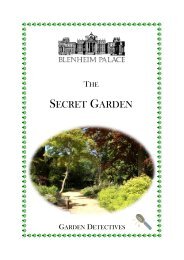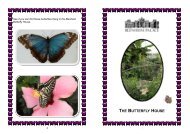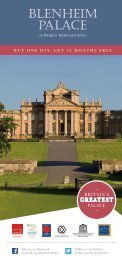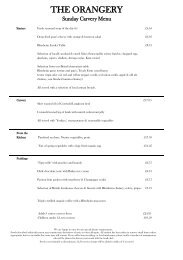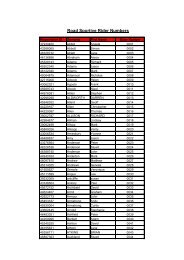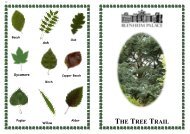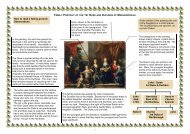Courtyard Capers - Blenheim Palace
Courtyard Capers - Blenheim Palace
Courtyard Capers - Blenheim Palace
You also want an ePaper? Increase the reach of your titles
YUMPU automatically turns print PDFs into web optimized ePapers that Google loves.
<strong>Blenheim</strong> <strong>Palace</strong> was built as a gift for the 1st<br />
Duke of Marlborough and his wife Sarah.<br />
Look carefully at the inscription above the gates<br />
at the entrance to the first courtyard.<br />
1. Who built the <strong>Palace</strong> according to this inscription?<br />
BLENHEIM PALACE<br />
HOME OF THE 11TH DUKE OF MARLBOROUGH<br />
The iron gates are not as old as the <strong>Palace</strong>.<br />
They were made in Victorian times by a<br />
company called Bramah. They were displayed<br />
at the Great Exhibition of 1851.<br />
5. Look at the stone decorations on the archway.<br />
List 3 different stone decorations.<br />
A man more famous for carving wood, Grinling Gibbons,<br />
carved many of the decorations on the archway of the<br />
gate.<br />
The man named in the inscription was the architect.<br />
The <strong>Palace</strong> was actually built by an army of labourers<br />
and many skilled stonemasons.<br />
Edward Strong and his son (also called Edward) were<br />
considered the most skilled of the stone masons. The<br />
stone came from nearby quarries in Oxfordshire and<br />
the Cotswolds.<br />
2. According to this inscription, when was the <strong>Palace</strong><br />
finished?<br />
The date on the inscription was actually the date the 1st<br />
Duke died, it was not the date when the <strong>Palace</strong> was<br />
completed. The <strong>Palace</strong> was built from East to West and<br />
the Chapel (in the West) was finished in 1733.<br />
3. Who gave the money to pay for the building of the<br />
<strong>Palace</strong>?<br />
The Flag flies to show that the Duke is at home. The<br />
flag is taken down when the Duke is away. A member<br />
of staff has to climb a very narrow spiral staircase<br />
hidden inside the arch to retrieve the flag.<br />
6. Who else in this country uses a flag to show whether<br />
or not they are home?<br />
These gates serve as the first entrance into the <strong>Palace</strong><br />
for all visitors.<br />
7. What information is available near these gates to help<br />
visitors?<br />
When the <strong>Palace</strong> is open, these gates always have staff<br />
present to help visitors. In previous times there would<br />
have been a Gateman on duty, often accompanied by<br />
some of the Duke‟s dogs.<br />
The 1st Duke and Duchess also paid<br />
some of the costs for building the<br />
<strong>Palace</strong>. This became necessary<br />
after they fell out of favour with the<br />
monarch, Queen Anne.<br />
4. What decorations can you see on the gate to<br />
show that a Duke or someone important lived here?<br />
There is a large area above the gates which houses<br />
an enormous cistern (tank). This was built to hold<br />
water for the <strong>Palace</strong>; the water was pumped up<br />
from the lake through pipes made of oak. The<br />
cistern is still there but it no longer holds the water<br />
supply for the <strong>Palace</strong>.<br />
8. Walk through the iron gates and look down at the<br />
ground.<br />
What are the cobbles made of?<br />
This particular type of cobble is used on the floor<br />
of all 3 archways. They were used to deaden the<br />
noise as horses pulled carriages through the<br />
archways.
The Orangery was originally used<br />
as a greenhouse and it did have<br />
orange trees in it. The 4th Duke<br />
(1758 - 1817) turned the Orangery<br />
into a 200 seated theatre because<br />
his children liked putting on plays!<br />
1. What is the Orangery<br />
used for today?<br />
When the Clock Tower<br />
was originally built,<br />
servants had to climb a<br />
narrow spiral staircase to<br />
set & adjust the clock.<br />
2. Look at the Clock<br />
Tower. How could the<br />
<strong>Palace</strong> Horologist<br />
(clock man) get up to<br />
the clockworks today?<br />
The clock in Kitchen<br />
Court was made in<br />
1710 by Langley<br />
Bradley. Four<br />
sundials were placed<br />
around the <strong>Palace</strong> to<br />
help staff keep the<br />
time of tower clock<br />
accurate. The tower<br />
clock has 3 other<br />
faces.<br />
3. Give 1 reason why<br />
3 faces of this clock<br />
are higher than the<br />
one you see in Kitchen<br />
Court.<br />
Kitchens<br />
Orangery<br />
Bake house<br />
KITCHEN COURT<br />
Clock Tower<br />
Kitchen<br />
Court early<br />
1700s<br />
Water Cistern<br />
above Gates<br />
Servants‟<br />
Common Hall<br />
Drying<br />
Area<br />
Laundry<br />
During the time of the 1st Duke<br />
& Duchess, Kitchen Court was<br />
a very busy place. There were<br />
many servants working hard in<br />
the Bakehouse & Kitchens.<br />
The laundry included rooms for<br />
ironing as well as for washing<br />
clothes. Porters were<br />
employed to fetch and carry as<br />
necessary.<br />
4. What jobs can you see being<br />
done by employees in Kitchen<br />
Court today?<br />
Servants’ Wages in the time of the 1st Duchess<br />
May King - Laundry Maid - £6 per annum<br />
Anne Middleton - Laundry Maid - £6 per annum<br />
Walter Jones - Porter - £8 per annum<br />
„The Necessary Woman‟ - for helping in the kitchens for 8 days<br />
- 5 shillings and 8 pence (29p).<br />
„The Washerwoman‟ - for 2 days help in the laundry - 2shillings<br />
and 6 pence (12.5p)<br />
When this courtyard was first built, it housed „useful‟ rooms. In Victorian times the<br />
purpose of some of the rooms changed; they changed again in recent years.<br />
Estate Offices<br />
Orangery<br />
Carpenters‟<br />
Shop<br />
Clock Tower<br />
Kitchen Court<br />
In Victorian<br />
Times<br />
Dairy<br />
Porter‟s<br />
Lodge &<br />
Gates<br />
Servants‟<br />
Hall<br />
Drying<br />
Room<br />
Retail Offices<br />
Conference<br />
Rooms<br />
Orangery<br />
Restaurant/<br />
Wedding<br />
Venue<br />
In the time of the 1st Duke, an „Odd Man‟<br />
and a „Necessary Woman‟ were employed<br />
at the <strong>Palace</strong>.<br />
The man did any odd jobs that needed<br />
doing. The woman did any job that was<br />
necessary.<br />
6. Look at the list of wages. Was the<br />
„Necessary Woman‟ well paid compared to<br />
the Laundry Maids?<br />
Clock Tower<br />
Kitchen<br />
Court Today<br />
Kitchens<br />
Gates<br />
Horse Trials<br />
Offices<br />
<strong>Palace</strong><br />
Shop<br />
5. Look around<br />
Kitchen Court.<br />
What evidence is there<br />
to show what Kitchen<br />
Court is used for<br />
today?<br />
The Kitchens were<br />
moved into the<br />
<strong>Palace</strong> by the 6th<br />
Duke in Victorian<br />
times. He wanted<br />
his food to be hot<br />
when it was served<br />
and felt that having<br />
kitchens in<br />
Kitchen Court was<br />
impractical.<br />
Today the Estate<br />
Offices are at<br />
Woodstock Gate.<br />
Toilets<br />
Storage
The <strong>Palace</strong> has approximately 1000 windows and 200<br />
rooms. The size of the windows vary according to the<br />
importance of the room and the people who would use it.<br />
The most humble servants were housed in the uppermost<br />
rooms which have tiny square windows - Housemaid‟s and<br />
Workshop Heights. The more important servants, the Butler<br />
and the Housekeeper were housed where you can see the<br />
round upper windows.<br />
1. How many small square windows can you see at<br />
the very top of the <strong>Palace</strong>?<br />
2. Find the 4 statues showing a lion<br />
mauling a cockerel. If the Lion represents<br />
Britain and the unfortunate cockerel<br />
represents France, what message do you<br />
think Grinling Gibbons, the sculptor, is<br />
trying to give us about the Battle of<br />
<strong>Blenheim</strong> and the countries which took part<br />
in it?<br />
GREAT COURT<br />
The eyes in the Portico were commissioned by the 9th Duke‟s 2nd<br />
wife, Gladys Deacon. She climbed to the top of the scaffold where<br />
the artist was working and showed him a scarf the exact shade of<br />
blue of her own eyes. The 3 blue eyes belong to Gladys - the<br />
inspiration for the brown eyes remains a mystery...<br />
In 1792, the following Window Taxes applied:-<br />
6 windows or fewer - nothing to pay.<br />
7 - 9 windows - 2 shillings (10p)<br />
10 - 19 windows - 4 shillings (20p)<br />
20 or more windows - 6 shillings (30p)<br />
A window tax was imposed in England from 1696 - 1851. This was<br />
seen as a taxation upon the very light by which people could see<br />
and gave rise to the expression, “daylight robbery”. Many people<br />
bricked up their windows to avoid paying the tax.<br />
5. If the Duke owned 4 neighbouring houses for his staff, the first<br />
one having 27 windows, the second one 13 windows, the third 2<br />
windows and the final one 8. How much window tax would the<br />
Duke have had to pay in total for the 4 houses?<br />
Vanburgh designed the <strong>Palace</strong> to be<br />
symmetrical (exactly the same on both sides<br />
if you were to draw a line down the middle.)<br />
The <strong>Palace</strong> was never completed and so the<br />
courtyard to your right ,if you stand facing the<br />
<strong>Palace</strong>, still remains to be finished.<br />
4. At the <strong>Palace</strong> front door, look up and count the eyes which are staring down at you.<br />
Why do you think Gladys Deacon had these eyes painted?<br />
6. Look around the courtyard and see if<br />
you can spot anything that looks unfinished<br />
and doesn‟t look symmetrical.<br />
This side of the <strong>Palace</strong> faces<br />
north. The east (left) side of the<br />
<strong>Palace</strong> was finished first and is<br />
where the 1st Duke and<br />
subsequent Dukes have their<br />
Private Apartments. Originally<br />
access to the east wing was via<br />
the steps leading up through the<br />
colonnades.<br />
3. Look around Great Court and name 3 things that<br />
would tell you that this <strong>Palace</strong> was built for a great<br />
soldier.<br />
7. Look carefully at the west wing. Where do you think the servants‟ entrance to the <strong>Palace</strong> was?
The Chapel at <strong>Blenheim</strong> <strong>Palace</strong> was finished in 1733, 11<br />
years after the death of the 1st Duke. It is still used for<br />
special family occasions and on 27th December 1874, Sir<br />
Winston Churchill was baptised here.<br />
Sarah, the 1st Duchess, had the monument erected in<br />
memory of her husband after the Chapel was built. When<br />
the Duke died in 1722, he was buried in Westminster Abbey,<br />
but his body was moved to rest beside Sarah‟s when she<br />
died and was buried below in the Chapel tomb in 1744.<br />
They still lie there together in their red leather coffins.<br />
1. Look at the monument, its inscription bears the date<br />
MDCCXXXIII in Roman numerals.<br />
If M = 1000, D = 500, C = 100, X = 10 V = 5 and I = 1,<br />
work out the date that the monument was erected.<br />
The first Duchess described the Chapel as „very<br />
plain‟. The organ, pews and some of the statues<br />
were installed in later years during the time of the 7th<br />
Duke and Duchess - a period when family and estate<br />
workers were summoned every day for morning<br />
prayers. The 9th Duke once commented that „the<br />
Marlboroughs are worshipped here.‟<br />
2. Consider the way the Chapel is laid out - what is unusual<br />
about the way the pews are facing?<br />
3. Look at how the Chapel is furnished then list 3 things<br />
that people might do in a church.<br />
4. Over the years this chapel has been used to mark<br />
many occasions - some of them happy and some of<br />
them sad. List 3 special events that might be<br />
celebrated in a church or chapel.<br />
5. Look around the chapel and see how many wyverns,<br />
dragons and other mythological creatures you can find.<br />
THE CHAPEL<br />
The medals on the walls either side of the<br />
monument are by John Croker - they<br />
commemorate the many victories of the 1st<br />
Duke and show the monarch at the time,<br />
Queen Anne. Two medals side by side<br />
represent both sides of the same medal.<br />
The Spencer-Churchill crest can be seen in the Chapel. The<br />
double headed eagle - a mythological (imaginary) creature -<br />
was the crest of the Holy Roman Empire of which the Duke<br />
had been made a Prince after his great victory at the Battle of<br />
<strong>Blenheim</strong>. The red Wyverns had a poisonous sting in their tails<br />
and were considered a sign of strength to those who carried<br />
them.<br />
The family motto, „Fiel Pero Desdichado‟ can be seen on<br />
the family crest. It means „Faithful but Unfortunate‟ and<br />
was adopted by the father of the first Duke whose name<br />
was Sir Winston Churchill.<br />
6. If you had a family motto, what would it be and why?<br />
Which animals would you choose to be on the crest?<br />
7. One of the medals beside the memorial commemorates<br />
the Duke‟s victory at Oudenarde (Aldenard). Using the<br />
information given to you in question 1, work out the date of<br />
the battle.<br />
Compare the medals showing Queen Anne with a coin<br />
showing our present queen. Can you see any similarities?<br />
In the Chapel, there are 3 statues of men, 1 of a woman,<br />
and 2 of children. While the woman, Sarah 1st Duchess,<br />
is dressed quite simply, the men are dressed in grand<br />
costumes or robes. The 1st Duke is dressed as a Roman<br />
general, the 7th Duke is in his Garter robes and Lord<br />
Randolph Churchill is dressed in his Parliamentary robes.<br />
All the statues were erected by women in memory of their<br />
husbands or sons.<br />
8. Look at the statue of the 1st Duke. Which animal can<br />
you see decorating the tops of his boots and the middle of his<br />
tunic?<br />
9. Find the statues of the 7th Duke and his son, Lord<br />
Randolph. How old was Lord Randolph when his father<br />
died?<br />
How old was Lord Randolph when he died? (In years and<br />
months.)
The Water Terraces were created<br />
under the watchful eye of the 9th<br />
Duke. He employed the services<br />
of the French landscape architect,<br />
Achille Duchêne. This area to the<br />
west of the <strong>Palace</strong> had originally<br />
been level and 25,000 cubic yards<br />
of earth had to be removed to<br />
create the different levels as seen<br />
today. A small track was<br />
constructed bearing wagons<br />
which were used to transport the<br />
earth away.<br />
1. Walk towards the Water Terraces<br />
Cafe. Stand on the paving slabs and<br />
find the one which commemorates the<br />
men who worked on the terrace. How<br />
many years did the Water Terraces<br />
take to complete and how many men -<br />
including the Duke - worked on them<br />
in total?<br />
THE WATER TERRACES<br />
3. Stand with your back to the <strong>Palace</strong>, look to your left where the steps go from the<br />
Water Terraces up to the South Lawn. There is a Latin inscription on the wall of the<br />
steps telling us that the work was ordered by the Duke, Charles (CAROLVS DVX).<br />
If M = 1000, C = 100 and X = 10, what year was this inscription dated?<br />
The 9th Duke was married twice.<br />
The face of his 2nd wife, Gladys<br />
Deacon appears on the head of the<br />
2 sphinxes who keep guard on the<br />
Lower Water Terraces.<br />
5. Look carefully at the sphinxes and<br />
see if you can spot who made them<br />
and when they were made.<br />
There are 4 sundials in the<br />
Gardens at <strong>Blenheim</strong> <strong>Palace</strong> -<br />
they were designed by John<br />
Rowley at the time the <strong>Palace</strong> was<br />
built. One of them was missing for<br />
some time - it had been sent for<br />
repair many many years ago. It<br />
was recently found in a box -<br />
together with the invoice for the<br />
repair work!<br />
The hedges on the Upper Water<br />
Terraces are box, and the water in<br />
the pools is piped from Rosamund‟s<br />
well - a spring which flows into the<br />
Park. The statues and plinths are in<br />
the classical Greek style.<br />
2. Stand on the Upper Water Terraces and<br />
look around you. The Terraces are<br />
decorated and adorned with all sorts of<br />
different items. What sort of things can<br />
you see decorating the Terraces in addition<br />
to the statues?<br />
The Water Terraces were designed to be symmetrical<br />
(exactly the same on both sides if you were to draw a line<br />
down the middle.) If you stand with your back to the <strong>Palace</strong>,<br />
you will see that the centrepieces in the 2 pools differ.<br />
The one on the right is by a very famous Italian artist called<br />
Bernini and is the model for the fountain which stands in the<br />
Piazza Navona in Rome. The centrepiece on the left was<br />
ordered by the 9th Duke to complement Bernini‟s work.<br />
4. Look carefully at the centrepiece erected by the 9th Duke.<br />
To whom has the dedication been made?<br />
6. There is a sundial in the<br />
centre of the Lower Water<br />
Terraces. Can you spot the<br />
Double Headed Eagle? Why<br />
does it appear on the sundial?<br />
Where was the last place you<br />
saw one?



